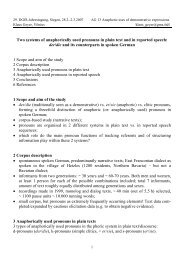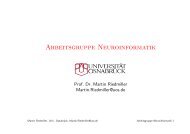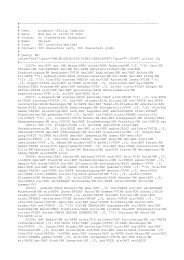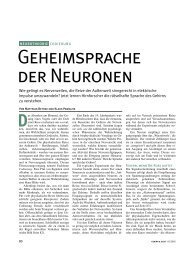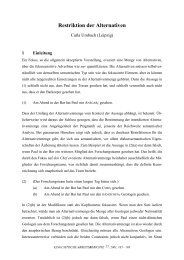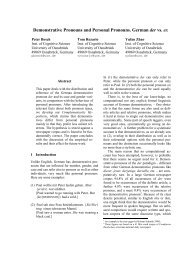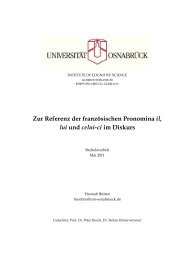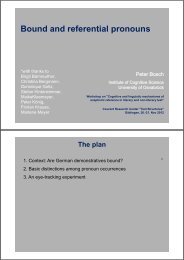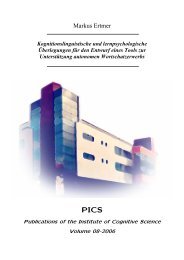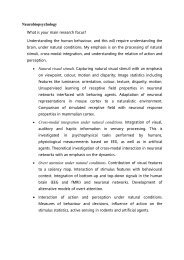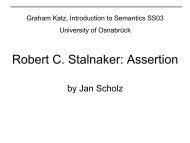Proceedings of the 6th Annual Meeting of the - Heinrich-Heine ...
Proceedings of the 6th Annual Meeting of the - Heinrich-Heine ...
Proceedings of the 6th Annual Meeting of the - Heinrich-Heine ...
Create successful ePaper yourself
Turn your PDF publications into a flip-book with our unique Google optimized e-Paper software.
Unfortunately, this proposal fails to distinguish between <strong>the</strong> pairs <strong>of</strong> examples in (38) and (39)<br />
above. Whereas a deletion rule with a syntactically specified environment prohibits <strong>the</strong> grammatical<br />
structures in (43), a deletion rule with a prosodically specified environment allows <strong>the</strong><br />
ungrammatical structures (38b) and (39b). Our surface coordination account captures meaning<br />
contrasts that a deletion account misses (our original motivation), and it explains why parts <strong>of</strong><br />
words occur in coordinate structures but not as objects <strong>of</strong> with or transitive verbs. We still need<br />
an explanation how a surface interpretation is possible for <strong>the</strong> non-coordinate structures in (43).<br />
I do not have an answer at <strong>the</strong> moment, but we should note that <strong>the</strong>se structures have parallels<br />
at <strong>the</strong> phrasal level: parts <strong>of</strong> words are allowed where parts <strong>of</strong> NPs are allowed.<br />
(45) a. Parliament developed from a unicameral to a bicameral institution.<br />
b. We transform <strong>the</strong> active into <strong>the</strong> passive sentence.<br />
c. ... taking over both <strong>the</strong> faction and <strong>the</strong> state chair.<br />
It appears, <strong>the</strong>n, that however <strong>the</strong> sentences above are interpreted, this should generalize to <strong>the</strong><br />
constructions with word parts.<br />
Why, <strong>the</strong>n, was deletion proposed in <strong>the</strong> first place? It turns out that most <strong>of</strong> <strong>the</strong>se arguments<br />
rest on assumptions about <strong>the</strong> rigidity <strong>of</strong> syntax and semantics, and are no longer valid when we<br />
consider a syntax and semantics capable <strong>of</strong> manipulating and interpreting parts <strong>of</strong> words.<br />
One argument for deletion is syntactic: sentences (46) and (47) contain apparent instances <strong>of</strong><br />
coordination <strong>of</strong> non-constituents: een derde and een zesde in (46), and ein Dreigang and ein<br />
Sechsgang in (47).<br />
(46) het verschil tussen een derde- en een zesdeklasser<br />
<strong>the</strong> difference between a third and a sixth-former<br />
(47) ein Dreigang- und ein Sechsgangfahrrad<br />
a three-speed and a six-speed-bicycle<br />
(Dutch, Booij 1985)<br />
(German, Kleinhenz 1997)<br />
Indeed, a syntax would need to allow some non-traditional constituents in order to generate <strong>the</strong><br />
above examples with surface coordination. Such syntactic <strong>the</strong>ories have been developed for nontraditional<br />
constituent coordination at <strong>the</strong> phrase level (“Right Node Raising”: Ades and Steedman<br />
1982; Steedman 1985, 1987), and a similar grammar is used by Moortgat (1987) for <strong>the</strong><br />
internal structure <strong>of</strong> words.<br />
Ano<strong>the</strong>r argument for deletion has to do with <strong>the</strong> semantics <strong>of</strong> number. Booij (1985) notes that<br />
<strong>the</strong> preposition tussen ‘between’ in (46) requires a plural complement, whereas on a surface interpretation<br />
its complement would be interpreted as singular because <strong>of</strong> <strong>the</strong> singular head klasser.<br />
The same problem, however, appears with coordination <strong>of</strong> determiner-adjective sequences that<br />
are whole words.<br />
(48) I must choose between a yellow and a red cabinet.<br />
I do not have an explanation for (48), and perhaps a deletion analysis can be motivated for it as<br />
well as for (46). However, this is not evidence for deletion in all cases <strong>of</strong> coordination <strong>of</strong> parts<br />
<strong>of</strong> words—no more than (48) is a motivation for deletion in <strong>the</strong> NP yellow and red cabinets.<br />
The next argument says that coordination <strong>of</strong> parts <strong>of</strong> words cannot be generated by <strong>the</strong> mechanism<br />
<strong>of</strong> syntactic composition because <strong>the</strong> conjuncts do not have to be free morphemes (49)–<br />
(50) or because <strong>the</strong>y can be lexical items <strong>of</strong> different categories (51)–(52).<br />
13



